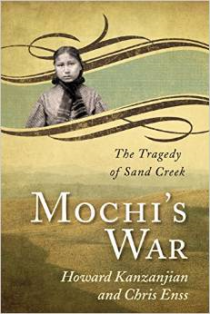Enter now to win a copy of Mochi’s War: The Tragedy of Sand Creek

Colonel John Chivington and representatives of the First and Third Colorado Cavalry rode hard and fast from the sun-touched butte where they’d been waiting at the Indian encampment along Sand Creek. A bugler sounded the charge as the horses’ hooves drummed and the soldiers shouted, reins in their teeth and guns in their fists. Members of the Cheyenne and Arapaho tribes living in the path of the cavalry hurried from their lodges and frantically scattered in different directions. Mothers scooped young children into their arms and ushered elderly men and women to clusters of trees. Braves grabbed weapons in order to defend themselves from the surprise invasion.
Several of Chivington’s troops raced to the paddock where the Indians’ horses were corralled. Without the herd the Indians would be at a disadvantage, unable to pursue attackers or flee from the chaos. Just before the flood of soldiers arrived on the scene, Colonel Chivington urged his men to “recall the blood of wives and children spilled on the Platte and Arkansas Rivers.”
The full force of the cavalry’s strike yielded immediate devastation. Bullet-ridden children fell where they once played; mothers lay dying with their babies in their arms; elderly women and men collapsed from gunshot wounds in their backs. It was a killing frenzy. Some Indians managed to escape without injury and take refuge in thick brush and behind scattered rock outcroppings.
Black Kettle tried desperately to keep his people from panicking. He clung to the belief that the attack would cease when the soldiers noticed the American flag unfurled. He and Chief White Antelope huddled at the base of the flag post. They only ran for cover when they realized the soldiers were hell-bent on annihilating them.
Fearless Cheyenne women and braves stood their ground, refusing to leave without a fight. The men exchanged shots with the soldiers and the women fought using spears and knives, all of which gave members of the tribe a chance to retreat slowly up the dried streambed. Many Cheyenne and Arapaho were killed as they ran to hide in the banks of the Sand Creek.
Indian horses spooked by gunfire broke away from the soldiers trying to drive them from the encampment. Indian women who managed to capture and calm a horse long enough to climb onto its back were shot. Their lifeless bodies slid from the backs of the horses onto the hard earth. Braves on foot who dared charge the relentless soldiers were stopped in their tracks with a barrage of bullets. According to accounts from those who witnessed the battle, children who ventured out of hiding waving white flags and mothers who pleaded for their infants’ lives were beaten with the butt of the soldiers’ guns and then scalped.
Black Kettle stood watching the bloody event in disbelief. He made a white flag of truce and raised it under the American flag. It had no effect upon the soldiers. Chivington’s persistent orders to continue to pursue the enemy were strictly followed. Black Kettle grabbed his wife, and the two fled toward a creek bed. The bark of the rifles all around him was steady, and there seemed to be no escape for the Cheyenne leader. Black Kettle’s wife was struck by several bullets, and the concussion of the shots knocked her face first onto the ground. Black Kettle tried to get her onto her feet again, but her injuries were too serious. The cavalry was bearing down on him quickly and he was forced to leave his wife’s body behind. He continued running until he reached the sandy creek bed. He hid in the dry wash under a thick overgrowth of brush.

To learn more about the Sand Creek Massacre read
Mochi’s War: The Tragedy of Sand Creek

